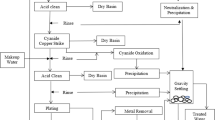Abstract
The present work studied the physicochemical properties, i.e., solubility and partition coefficient and toxicity level of eight corrosion inhibitors (CIs), including two commercial CIs and six synthesized CIs by green chemistry as an ecological alternative to commercial CIs. The six environmentally friendly CIs were synthesized considering the basic principles of green chemistry, under ambient temperature and pressure conditions and in the absence of solvents, with a mass reaction efficiency greater than 80% and without the generation of residues. The chemical structure of the CI, the temperature, and the solvent are factors that determine CI solubility; most CIs exhibit greater solubility in polar media, such as isopropanol: saline solution mixture. The partition coefficient in the aqueous phase: organic phase and mixtures with different volumetric proportions were higher for the environmentally friendly CI in an 80:20 vol% mixture. The partition coefficients of the green inhibitors increased with increasing size of the hydrocarbon chain and with increasing number of zwitterionic groups, obtaining the following order: CI-R18/2 \(>\) CI-R16/2 \(>\) CI-R12/2 \(>\) CI-R18 \(>\) CI-R16 \(>\) CI-R12. The 50% effective concentration (EC50), based on stimulation of root growth of Allium cepa, was lowest for CI-IMPG2 and CI-R16-2. The CIs with the lowest % MI were CI-R16/2 and CI-IMPG2, showing less cytotoxic damage, and those with the highest % MI were CI-R12 and CI-PG12A, showing greater cytotoxic damage.














Similar content being viewed by others
References
Basargin YM, Budnikov VF, Bulatov AI (2004) Theory and practice of prophylactics of troubles and repair of wells during their construction and operations. A reference manual. eNedra-Businesscenter, Moscow
Díaz Báez MC, Pica Granados Y, Ronco A (2004) Ensayo de toxicidad aguda con bulbos de cebolla Allium cepa L mediante la evaluación de la inhibición del crecimiento promedio de raíces. G.Castillo, Canadá
Enrique GJ, Mena-Cervantes VY, Jorge V-A, Gabriel PF, Raúl H-A (2018) Inhibition of CO2 corrosion via sustainable geminal zwitterionic compounds: effect of the length of the hydrocarbon chain from amines. ACS Sustain Chem Eng 6:17230–17238. https://doi.org/10.1021/acssuschemeng.8b04619
Espinosa Aguilar BA, De la Cruz Morales JC (2015) Cuantificación de inhibidor de corrosión en salmuera NACE 1D182 por la técnica de Ultravioleta Visible. Tesis de Licenciatura. Escuela Superior de Ingeniería Química e Industrias Extractivas. Instituto Politécnico Nacional., Distrito Federal
Estados Unidos Patente no. US 6,475,431 B1, 2002.
Fiskesjö G (1988) The Allium test—an alternative in environmental studies: the relative toxicity of metal ions. Mutat Res 197(2):243–260
McMahon AJ, Groves S (1995) Corrosion Inhibitor Guidelines. A practical guide to the selection and deployment of corrosion inhibitors in oil and gas production facilities. (BP, Sunbury Report No. ESR. 95. ER. 050, 1995) 11–46
NACE International/ ASTM G193–12d (2012) Standard terminology and acronyms relating to corrosion. ASTM International, West Conshohocken. https://doi.org/10.1520/G0193-12D
Palou MR, Olivares-Xomelt O, Likhanova NV (2014) Environmentally friendly corrosion inhibitors. Intech Open 19:430–437. https://doi.org/10.5772/57252
Popoola LT (2019) Organic green corrosion inhibitors (OGCls): a critical review. Corros Rev 37(2):71–102
Quiroz R, Rosales A, Barón E (2007) Evaluación de la inhibición de la corrosión por CO2 en sistemas de fluido multifásico estratificado. Revista Técnica De La Facultad De Ingeniería. Universidad Del Zulia 30(Especial):261–271
Ramírez-Estrada A, Mena-Cervantes VY, Elizalde I, Manzo-Robledo A, Zamudio-Rivera LS, Nieto-Álvarez DA, Farelas F, Hernández-Altamirano R (2017) Development of a zwitterionic compound derived from β-amino acid as a green inhibitor for CO2 corrosive environments. ACS Sustain Chem Eng 5:10396–10406
Ríos RF (2014) Comportamiento Ambiental de tensoactivos comerciales: biodegradabilidad, toxicidad y ozonización. Universidad de Granada, Gradanda
Singh R (2014) Pipeline integrity handbook: risk management and evaluation. Gulf Professional Publishing, Waltham
Singh JO, Bockris M (1996) Toxicity issues of organic corrosion inhibitors: applications of QSAR model. In: Proceedings of the NACE-Corrosion 1996
Zaferani H, Sharifim M, Zaarei D, Shishesaz MR (2013) Application of eco-friendly products as corrosion inhibitor for metals in acid pickling processes: a review. J Environ Chem Eng 1:652–657
Zakeri A, Bahmani E, Aghdam ASR (2022) Plant extracts as sustainable and green corrosion inhibitors for protection of ferrous metals in corrosive media: a mini review. Corros Commun 5:25–38
Acknowledgements
This research was financially supported by SECTEI 243-2020, SECTEI 093-2023 and SIP-IPN multidisciplinary 2188 research projects. We give special acknowledgments to the Laboratorio Nacional de Desarrollo y Aseguramiento de la Calidad de Biocombustibles (LaNDACBio).
Author information
Authors and Affiliations
Corresponding author
Additional information
Publisher's Note
Springer Nature remains neutral with regard to jurisdictional claims in published maps and institutional affiliations.
Rights and permissions
Springer Nature or its licensor (e.g. a society or other partner) holds exclusive rights to this article under a publishing agreement with the author(s) or other rightsholder(s); author self-archiving of the accepted manuscript version of this article is solely governed by the terms of such publishing agreement and applicable law.
About this article
Cite this article
Huerta-Servin, R., Ahuatzi-Chacón, D., Salmerón-Alcocer, A. et al. Effect of solubility and partition coefficient on the toxicity of corrosion inhibitors used in the oil industry. Chem. Pap. 78, 3063–3081 (2024). https://doi.org/10.1007/s11696-023-03293-2
Received:
Accepted:
Published:
Issue Date:
DOI: https://doi.org/10.1007/s11696-023-03293-2




